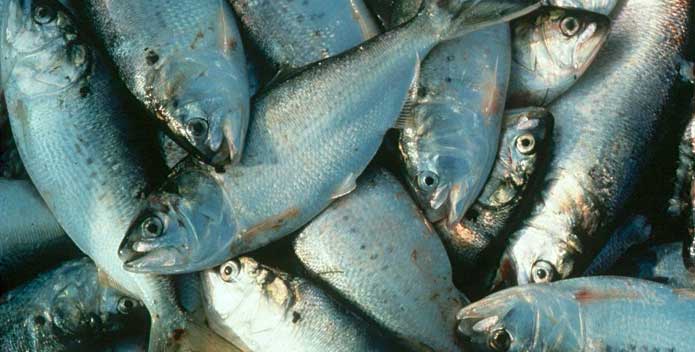The following first appeared in Salt Water Sportsman, Sport Fishing Magazine, and Boating Magazine.
"No man is an island."—John Donne
Nor any fish either, or really any living plant or animal. We are all bound together in a mind-bogglingly complex web of life, in which what happens to one species affects multiple others. Yet up to now, we have governed many of our natural resources in a vacuum called single-species management. The system has the great advantage of being far simpler than ecosystem-based management, and it has worked reasonably well for a number of predator fish like striped bass, red drum, and bluefish. Applying it to forage fish, though, is far more complex, because a change in availability of one species of food ripples out as predators (often including protected marine mammals and birds as well as valuable stocks of predator fish) shift to other food sources and begin competing with one another for them.
Welcome to the new world of fisheries management, in which we find that we must reserve some portion of specific forage stocks for the rest of their ecosystem when we calculate how much of them we can harvest for human needs. It's hard: a real challenge for fishery scientists, and it's coming to a coast near you, whether it concerns Pacific anchovies or Gulf menhaden in the Gulf of Mexico.
The first test looks like it's going to play out over the next five years or so for Atlantic menhaden, the bunkers and pogies so much beloved from Florida to Maine by stripers, red drum, black drum, speckled trout, gray trout (weakfish), flounder, bluefish, king mackerel, and even bluefin tuna, as well as water birds like gannets, ospreys, pelicans, seagulls and marine mammals like bottlenose dolphins. But they are also fished hard for industrial uses, specialized animal feeds, human nutrition supplements, and bait, especially for crabs, lobsters, and us recreational anglers. Yup, that's why our bunkers and pogies are sometimes called "the most important fish in the sea."
To balance all of these needs with the fish's reproductive capacity, the members of the Atlantic States Marine Fisheries Commission in 2015 directed their Technical Committee to begin development of Ecological Reference Points (ERPs) for management of Atlantic menhaden. The Commission will use these ERPs to set coast-wide annual mortality fishing targets and thresholds plus Total Allowable Catch for these essential building blocks in the Atlantic coastal food web while keeping the needs of their predators in mind.
The problem is that it will take at least two more years to develop the specific ERPs fully. As we said, it's complicated. Think about that the next time you see a school of bunkers being driven to the surface by stripers trying to fatten up for the winter.
So, what do we do in the interim? Fortunately, there has been some cutting-edge research done on forage fish ERPs for a number of species, and that offers guidance on the use of this ecological approach. Based on them, ASMFC has established options for interim ecological management through the development of Amendment 3 of its plan for Atlantic menhaden. Here's the text of the Draft Plan for Amendment 3. It's long, though. For more information, a summary of Amendment 3, and some ways to take action to protect these vital forage fish, visit the Chesapeake Bay Foundation's menhaden pages.
Single-species management? Nope, it won't work for the future of menhaden in the Atlantic, and probably not anywhere else either. We must balance our 21st-century harvest capabilities with equally modern management strategies if we want the marine ecosystems we love to prosper.
The Atlantic States Marine Fisheries Commission (ASMFC), the group of Atlantic coastal state representatives that manages and conserves nearshore fish species, is accepting public comments on proposed changes to its menhaden management plan. Send a message to ASMFC right now—before the October 20 deadline—advocating for a strong, ecosystem-based management plan for menhaden.




